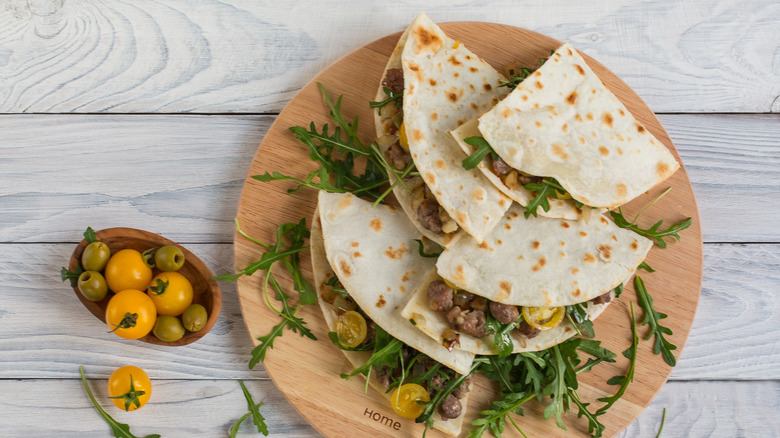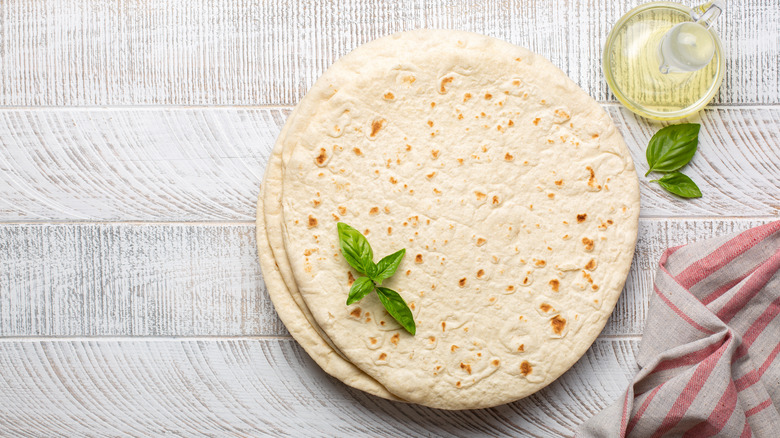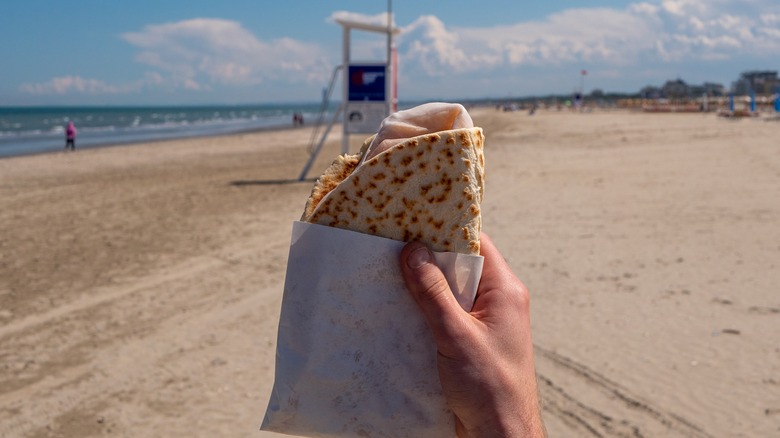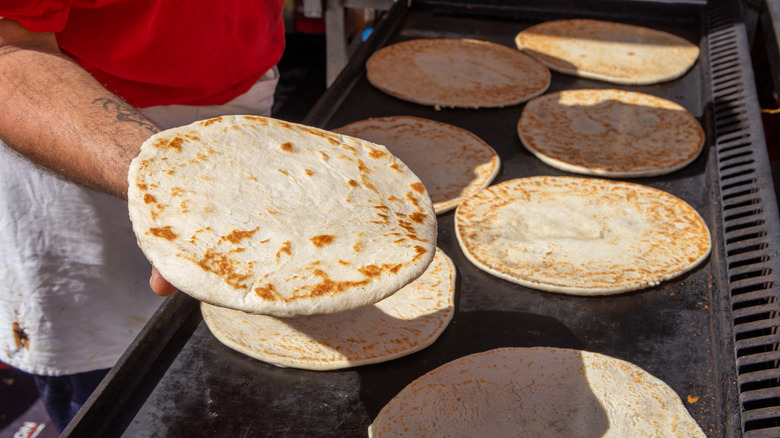Italy's Piadina Flatbread Is The Perfect Meal On-The-Go
Fast food has vastly different meanings depending on where you are in the world. Here in the United States, we've basically built our modern culture around two things: the automobile and the fast food restaurant. Establishments like McDonald's, Kentucky Fried Chicken, and In-and-Out Burger, despite humble beginnings as small operations, have defined American food culture for the last 60 years (via Smithsonian). However, this love of the fast food joint is not universally shared. According to Rick Steves, Italians have a rather mixed view of American food. Despite enjoying some of our more popular creations, like BLTs or Buffalo wings, the Italians Steves interacted with believe that American food is more about cooking up what sells rather than cooking up what's good. This begs the question: what do Italians consider to be fast food?
When you think about Italian fast food, you likely think of pizza, right? Well, there lies your answer. Pizza is very easy to make in large quantities. Sure, it's not going to be drive-thru-burger fast, but it's quick and simple enough to fuel you in a jiffy for minimal cost. Traditional Neapolitan pizza is prepared in a matter of minutes, cooking quickly in the deep inferno of a stone oven (via MasterClass). However, there is more to on-the-go Italian food than just pizza. In this fast-paced world, options are needed to keep things interesting. As opposed to burgers and fries, the Italians have a different pick-up food that stretches back centuries: piadina flatbread.
What is piadina?
Regionalism is a defining characteristic of Italian cuisine. The breads, meats, and pastas of Emilia Romagna, for instance, are going to be a lot different than the sausages and pizzas of the arid southern mountains of Calabria. Emilia Romagna, however, is unique in another way. Though not officially recognized as divided by the Italian government, Emilia Romagna is actually split into two distinct regions within regions. Emilia is the northern half, and Romagna is the south. And it is from this southern coastal area that piadina comes (via Eataly).
Piadina, in its most ancient form, is known to have existed in Italy as far back as 1200 B.C. Evidence was discovered amongst archaeological remains dating back to that time. Variations of the flatbread were popular throughout Ancient Rome and into the Middle Ages. The first written account of piadina was scribed by a Cardinal Angelico in 1371. In his account, he declared piadina a genuine cultural artifact of the Romagna area. The tradition of making piadina was passed down throughout the centuries, eventually becoming commercially popular in the early 20th century and remaining a staple ever since (via Loriana la Piadina).
The significance of cucina povera
When it comes to understanding piadino it is important to understand the significance of cucina povera in Italian culture. Cuncina povera translates into "food of the poor." It is the food the vast majority of Italians used to cook when the country was mired in poverty. Living in the country's rural areas made it difficult to buy ingredients that couldn't be produced at home. As a result, affordable ingredients such as grains, beans, vegetables, and fruits became the staples of Italian kitchens. Dishes we consider iconic today, such as pasta, polenta, and gnocchi, all have their feet set firmly in the tradition of cucina povera (via Citalia).
Piadina hails from this tradition. Bread was another important component of cucina povera. Although piadina is an unleavened flatbread, it is bread nonetheless. According to Eataly, piadina represents the best elements of the cucina povera mentality by "turning the most humble of ingredients into something satisfying and delicious." Like any flatbread, piadina is a combination of affordable ingredients whipped up into something flavorful and adaptable across multiple recipes.
How it's made and how to eat it
The process of making piadina is very simple and can easily be done at home. Remember, piadina is a flatbread and is therefore made with relatively few ingredients. The dough is a simple combination of flour, lard or olive oil, salt, and a wee bit of baking soda, which is then rolled thin and cooked on either a hot griddle or a traditional terracotta plate. However, you can just as easily use a heavy-bottomed cast iron skillet. Once finished, the piadina is folded in half, lengthwise, forming a sort of half-moon. After a brief cooling, the piadinas are stuffed like sandwiches using a mixture of cured meats, cheeses, and balsamic vinegar. Or, if you've got a sweet tooth, you can fill your piadina with chocolate, fruit, or whipped cream (via MasterClass).
As piadina is a favorite of Emilia Romagna, the classic way to serve this scrumptious flatbread is to make a sandwich filled with traditional regional ingredients. According to Eataly, the classic combination for a Piadino Romagnola is Prosciutto di Parma, mozzarella, and arugula. Serve with a classic Emilian wine like Lambrusco, and you have yourself a wonderfully savory and refreshing little lunch.



